- 12 May 2023
- 4 Minutes to read
- Print
- DarkLight
- PDF
RapidSpike
- Updated on 12 May 2023
- 4 Minutes to read
- Print
- DarkLight
- PDF
An advanced website monitoring platform for performance, security, and reliability.
AlertOps and RapidSpike
AlertOps’ alert management system can be integrated with RapidSpike to receive and respond to critical (predefined status mappings) uptime alerts through email, SMS, push notification or phone alerts. AlertOps would ensure that the alert would reach the appropriate team by using proper workflows, escalation policies and schedules. Based on your ruleset, incidents can be automatically opened and closed, depending on whether RapidSpike reports an uptime monitoring problem or a recovery.
The above scenario and scope for integration is since AlertOps has a very flexible and simple API/Webhook configuration feature that can be leveraged with RapidSpike’s monitoring and alerting capabilities.
AlertOps - Inbound Integrations
We can define some rulesets in AlertOps so that RapidSpike can send out notifications to the AlertOps platform. AlertOps would ensure based on these notifications received, that it would always reach out and assign to the correct person/team by utilizing its escalation policies, schedules, and workflow features.
AlertOps provides Inbound Integrations to integrate with numerous monitoring, chat and ITSM tools. You can configure an inbound integration for RapidSpike incidents.
At a high level this is how the flow looks like, you define an API integration in the AlertOps platform by defining settings like Integration Name, Escalation rules, recipient users/groups. Once an integration is defined, a unique API URL is generated. This acts as webhook or the gateway through which notifications from RapidSpike reach AlertOps and thus an incident/alert is created correspondingly. The API can be defined with various settings like URL mappings, filters, escalations etc. as required.
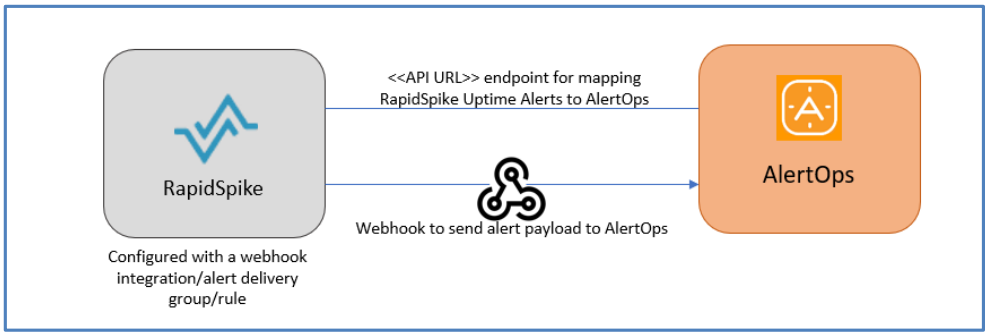
Configure Inbound Integration in AlertOps
- In the menu on left pane, select Integrations > Inbound Integrations > Add API Integration.
- There are numerous integration options available in AlertOps, select RapidSpike
- Once you select the integration, you can then specify basic settings like the integration name, escalation policy, names of the recipients/groups for which the alerts must be assigned to.
- Once you click save, the API Integration will be created, and you will be given a unique URL which acts as the access point and needs to be configured at the source (in this case RapidSpike), to send alerts. You can find the integration you just created, and you can give advanced settings and define various configurations for the alerts to be received and processed. For example, you can define when to open and close alerts based on the payload obtained from the API call, filters etc
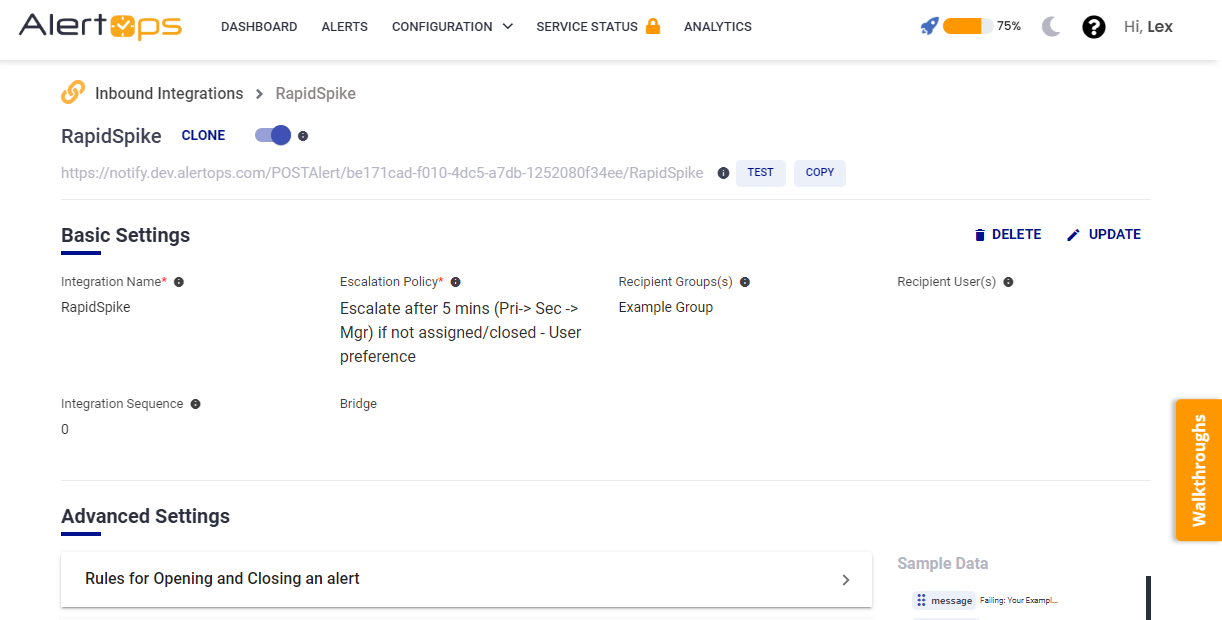
- AlertOps automatically creates an alert when the status variable (monitors_0^state) is ‘failing’.The incident will also be closed automatically when the status ‘passing’ is received.
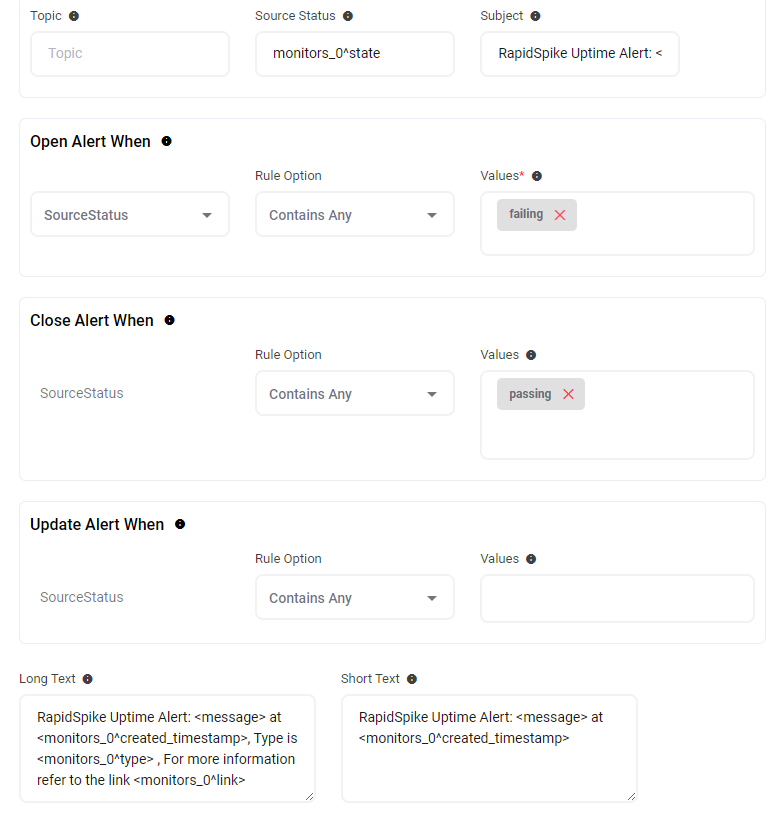
You can similarly define Rules for Opening and Closing Alerts as you want in Advanced settings, owing to the flexibility provided by AlertOps’ OpenAPI integrations. You can provide other filters and match with regex expressions as well. You can also test the generated URL.
Configure Integration in RapidSpike
RapidSpike alerts and notifications allow you to set robust and configurable alerting policies that enable you to get notified about changes or issues affecting your website/server’s uptime. For more information refer to the links in the Reference section. You need to define Alert delivery groups and attach it to an uptime rule.
To setup an Integration Webhook to send out alerts to AlertOps,
- In the left navigation tab of your RapidSpike dashboard, under Global Settings and Account, select ‘Integrations’.
- Select ‘Add’ under Webhooks. Give a label, paste the API URL which you obtained in the previous section and select the Request Type as POST. You can provide custom headers if any. Click Add. You can test by sending a sample alert to AlertOps.
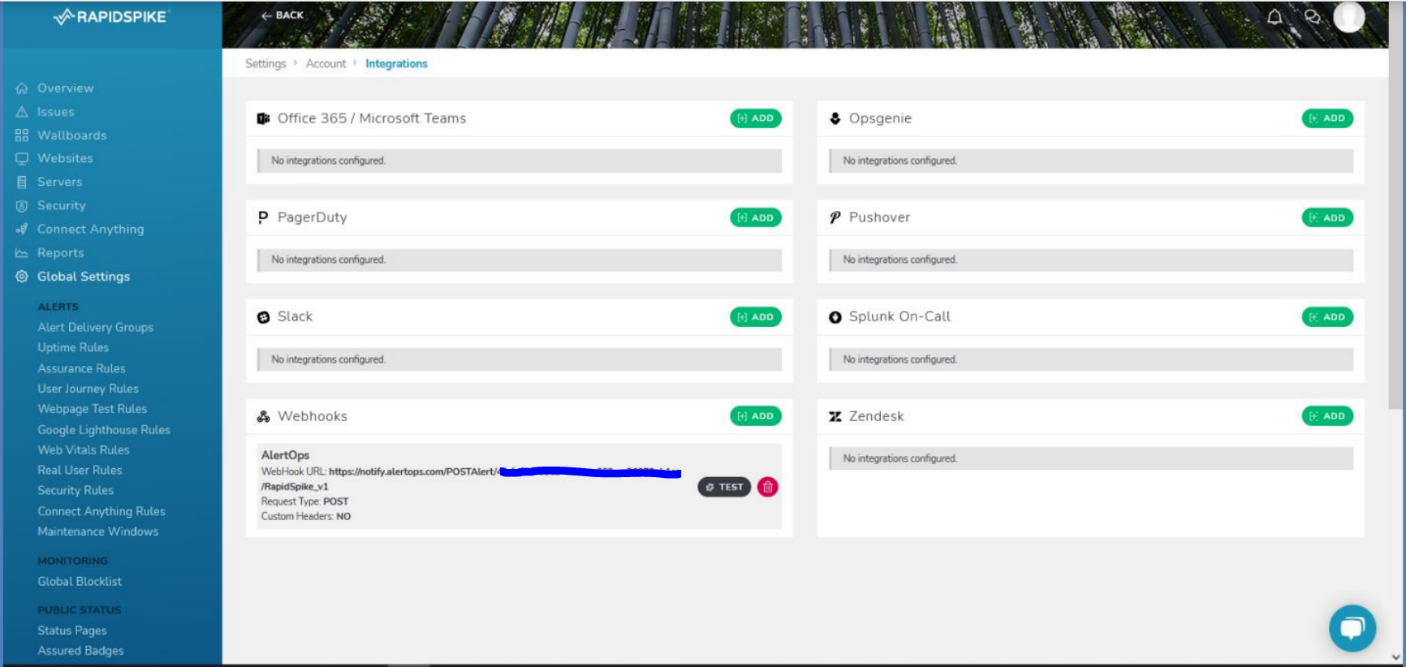
To define Alert Delivery Groups and Alert Rules for Uptime,
- Alert Delivery Groups serve to define various ways in which one can get notified and how. For example, you can have one delivery group for one team associated with a method of delivery, and another delivery group for another team with another method of delivery Each group can be colour coded for discerning different types of alerts and notification methods.
- Under Global Settings and under Alerts, select Alert Delivery Groups > ‘Add Delivery Group’, give a label, assign sensitivity, color and notification methods. Click Update. (Under Webhooks make sure you select the Webhook which you defined in the previous step)
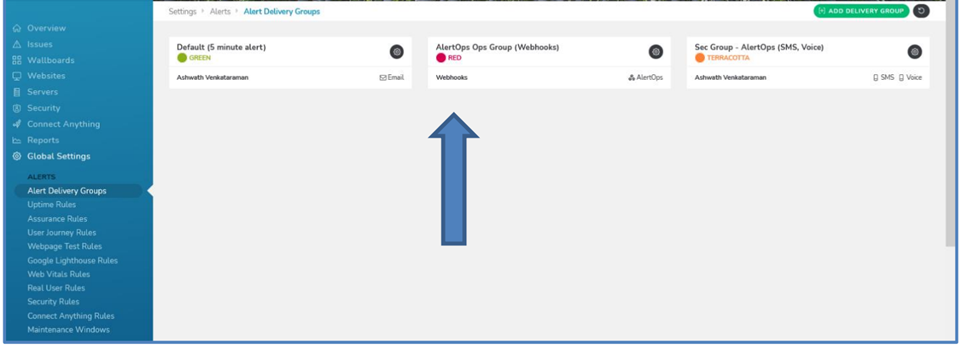
- Under Alerts select Uptime Rules. Find the website or server you might have created in RapidSpike (or any other configuration you might have done), click ‘Add Rule’. Under Delivery Groups make sure you select the group/groups which you defined in the previous step.

You have created a Webhook Integration, Alert Delivery Group and an Uptime Alert Rule, that would send out notifications to AlertOps when the alert condition is triggered (in this case when there is a problem in Uptime monitoring of the server/website)
Alerts in AlertOps can be seen in the "Inbound Log" or "Alerts" section in your AlertOps environment.

Alert Triggering Information
AlertOps will automatically create an incident when a new alert is received from RapidSpike when the monitors_0^state field contains “failing”.
If an alert with status “failing” matches an existing Open Alert, AlertOps will recognize the new alert as a duplicate and ignore the alert. The alert will be recorded in the Inbound Messages table as “Mapped Appended.”
AlertOps will automatically close the same incident when an alert with monitors_0^state contains “passing”.
References
RapidSpike Alerts and Notifications


